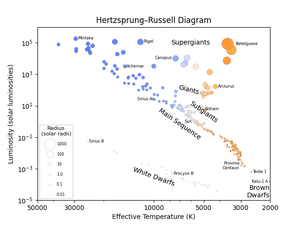Glossary term: White Dwarf
Description: Stars with mass up to eight times the mass of the Sun are expected to end their lives as white dwarfs. This includes our Sun. White dwarfs have very high densities, and a typical white dwarf could have the mass of the Sun squeezed into a ball slightly larger than the size of the Earth. A white dwarf is no longer producing energy from nuclear reactions in its core, but shines due to its leftover energy. The hotter ones appear blue or white because of the energy they radiate due to the very high temperatures on their surfaces. The core of a white dwarf could be made up of helium or carbon–oxygen or oxygen–neon–magnesium depending on the initial mass of the star. It does not contract under self-gravity due to resistance within its interior from electron degeneracy pressure – a quantum phenomenon. Degeneracy pressure can only support white dwarfs with masses up to 1.4 times the mass of the Sun. Stellar remnants with masses greater than this limit (known as the Chandrasekhar limit) are either neutron stars or black holes.
Related Terms:
See this term in other languages
Term and definition status: This term and its definition have been approved by a research astronomer and a teacher
The OAE Multilingual Glossary is a project of the IAU Office of Astronomy for Education (OAE) in collaboration with the IAU Office of Astronomy Outreach (OAO). The terms and definitions were chosen, written and reviewed by a collective effort from the OAE, the OAE Centers and Nodes, the OAE National Astronomy Education Coordinators (NAECs) and other volunteers. You can find a full list of credits here. All glossary terms and their definitions are released under a Creative Commons CC BY-4.0 license and should be credited to "IAU OAE".
If you notice a factual error in this glossary definition then please get in touch.
Related Diagrams
Hertzsprung-Russell diagram
Credit: IAU OAE/Niall Deacon
License: CC-BY-4.0 Creative Commons Attribution 4.0 International (CC BY 4.0) icons









